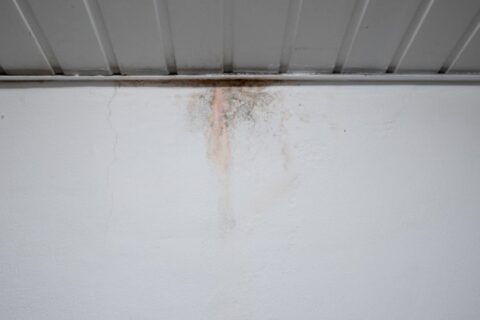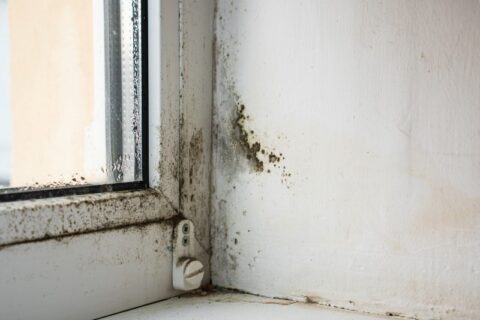Tips for Mold Prevention
Mold Remediation Advice From the Pros at Everdry Waterproofing
Everdry Waterproofing has been providing 100% effective waterproofing solutions for homeowners since 1989. Our team has turned areas of houses prone to wet conditions and mold growth into worry-free, viable living spaces for over 85,000 satisfied customers. One of the most common reasons property owners reach out to us for our waterproofing solutions is concern over mold growth. The key to mold control is moisture control, and the waterproofing experts at Everdry Waterproofing are here to share information about what mold is, how it forms, and what you can do to prevent mold from growing in your home.
What Is Mold? Is It Bad for You?
Mold is a fungus that can grow just about anywhere, including on food, shower curtains, ceilings, walls, and even basement walls and floors. People are exposed to mold every day, as it plays an essential role in nature by aiding in the decomposition of leaves and trees. In small doses, mold is usually harmless to most people, but if mold has the opportunity to grow indoors, especially in poorly ventilated areas, mold spores can be released into the air and inhaled by humans in larger quantities. This type of exposure comes with health risks.
Are There Different Types of Mold?
Mold does not have a very good reputation. It is mostly associated with spoiled fruit, stale bread, and discolored walls and not its vital role in nature. While molds are important, people need to be aware that prolonged exposure and ingestion of the mycotoxins that some species can produce are a serious health risk. People with allergies, asthma, or weakened immune systems have the highest chance of experiencing health issues from mold exposure. Mold is categorized in three main groups. Each one can cause different reactions for people who come in contact with them, from itching eyes and sneezing to more serious skin rashes and respiratory problems. The categories are:
- Aspergillus: This type of mold is most often found in dead leaves, compost piles, and other decaying vegetation.
- Penicillium: This type of mold is commonly found on food as it begins to spoil. Some species do not produce harmful toxins. In fact, some strains of Penicillium are used to make the strong antibiotic penicillin, and it is also used in cheesemaking.
- Cladosporium: This is a common indoor mold that can grow on fabrics, carpets, under floorboards, and inside of cupboards.
How Does Mold Form?
Under favorable conditions, any of these molds can grow without much help and will continue to multiply as the conditions remain the same. What makes mold so pesky and difficult to control is that the conditions it thrives in are usually prevalent in areas of the home that are often overlooked or homeowners don’t have access to, such as a crawlspace or dingy basement. Since mold is found in air and dust particles, it can easily travel into the home where many building materials, such as wood products, fabrics, and paper products, supply the nutrients that encourages mold growth. As mold attaches itself to surfaces, it looks for the following to grow and spread:
- Moisture: Damp conditions are usually the start of mold growth. It could be a pile of damp towels, a leak, a broken appliance, or any other wet conditions.
- High Humidity: This is similar to moisture, but even without a direct water source, mold can grow in humid conditions, usually in areas where the air is 55% humidity or higher.
- Poor Ventilation: Stagnant air or lack of fresh-air promotes mold growth.
- Dark Spaces: It’s important to note that mold can grow in both dark and light spaces, but dark spaces are included as a favorable condition because the lack of light makes it more difficult for wet conditions to dry out.
Pay Close Attention to These Areas of Your Home for Mold Growth
As mentioned, mold has an easy time growing undetected because it often spreads in areas that are hard to see or neglected. The source of moisture may be hidden from view or the surface the mold is growing on could be concealed by an appliance or piece of furniture. Any part of a house can grow mold in the right conditions, but some of the most common areas for mold growth in homes are:
- Basements: Whether your basement has a dirt floor, poured concrete foundation, or is completely finished, all basements are prone to taking in water through rising water tables, cracks in the floor or walls, or downspouts that are too close to the house. Once moisture enters the basement, a lack of ventilation can quickly instigate mold growth.
- Attics: A leak in your roof that allows water in an attic each time it rains will likely create a mold issue. Attics include materials that mold can quickly grow on, including wood beams and floorboards, sheetrock, and insulation. If your attic is a crawlspace that is difficult to access, mold can become a huge problem if left unchecked.
- Bathrooms: Hot, steamy showers provide two critical ingredients that mold needs to thrive: moisture and humid air. Bathrooms that don’t have a ventilation fan are especially prone to mold because they’re supplied with a third ingredient — stagnant air. Dark mold spores grow on shower curtains as well as shower tiles, walls, and ceilings. These are usually easy to spot.
- Kitchens: Leaking faucets, drains, and appliances can all provide mold the moisture it needs to grow on surfaces. Also, when cooking, such as boiling pasta, poor ventilation creates humid air conditions that will allow mold to stick to walls.
Tips to Prevent Mold From Growing in Your Home
Everyone will have to learn to live with a little bit of mold in their lives. It’s a natural part of the environment and exists in the air all around us. The key is to limit the growth and spread of mold inside of our homes where it can create unhealthy conditions and cause damage. Homeowners who are aware of the conditions mold thrives in as well as rooms in the house that are the most susceptible to mold growth are a step ahead in the battle to prevent mold from growing. Here are some helpful tips to prevent and limit mold growth in your basement, bathroom, or anywhere else in your home:
- Keep it Dry: At the first sign of a leak or flood, dry and clean your home. This may require a wet-vac, fans, or an industrial-strength dehumidifier, depending on the extent of the water damage.
- Use a Dehumidifier: Keeping humidity levels at or below 50% all the time is ideal, and this is easily accomplished with a dehumidifier. These work great in basements that are typically damp with poor ventilation.
- Ventilate: Kitchens and bathrooms benefit from ventilation fans that are connected to the outside of the house.
- Use Proper Floor Coverings: Try to avoid carpeting in basements and bathrooms, as these can trap in moisture and grow mold.
- Use Proper Paint: Paint manufacturers make lines of paint that hinder mold growth, or you can add mold inhibitors to paints that don’t have them. These are good choices for walls and ceilings in bathrooms and basements.
- Check Gutters: Ensure that your gutters are in good shape, and the downspouts lead away from your home. Rainwater that is released directly into the ground at your foundation can make its way into your basement.
- Maintain Your Home: Stay ahead of possible leaks by keeping up with the roof, fascia, window, and plumbing maintenance.
How Can I Get Rid of Mold in My Home?
The best way to handle mold is by preventing it from growing and spreading in the first place using the techniques listed above. If you do find yourself in the unfortunate situation of having mold in your home, you may be able to clean it yourself. Mildew is a common type of mold that many homeowners can remove with household cleaners. It is critical that every homeowner understand that many molds are harmful and require the work of professionals offering mold remediation. Experts should handle large swaths of black mold in carpeting, walls, or other areas of the home since spores released into the air can be harmful if not contained. If it’s a small area of mildew, less than 10 square feet, you can try cleaning with one of these materials using proper protective equipment and following all instructions on the label:
- Chlorine Bleach
- Hydrogen Peroxide
- Distilled White Vinegar
- Baking Soda
- Borax
Keep Your Basement Dry With Everdry Waterproofing
Your best defense against mold growth in your home is keeping it dry. The basement waterproofing solutions from Everdry Waterproofing keep homes in Milwaukee, WI dry starting at the foundation where most water problems begin. Keeping water out of your basement will limit the growth and spread of mold, protect your belongings, and add function to your basement. Have questions about our waterproofing techniques? Our friendly team of professionals is here to discuss all of our services and answer any questions you have. Contact us to schedule an estimate and get one step closer to having a dry basement free of mold!
Ready to Get Started?
Contact Us Today to Schedule a No Pressure, No Obligation, Free Quote!


